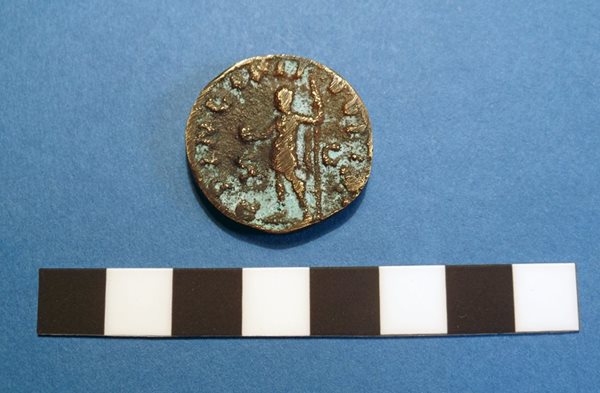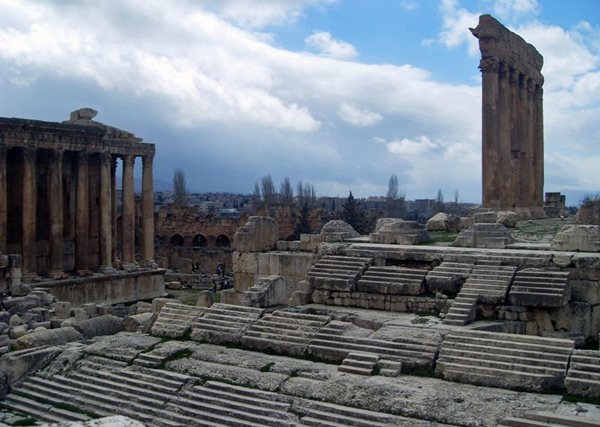Circa AD 245-247
Roman Coin of Philip the Arab
Found in Co. Cork
By Leo McNameeDescription
This Roman coin is a copper alloy sesterius minted during the reign of Philip the Arab who was the Roman Emperor from AD 244 - 249. One face of the coin bears the youthful bust of the emperor, he is shown bare headed with drapery over his shoulder and facing to the right. The inscription reads M IVL PHILIPPVS CAES (Marcus Iulius Philippus Caesar). The reverse shows the emperor standing in military dress and facing to the left – he is holding a globe in one hand and either a staff or spear in the other. The inscription reads “PRINCIPI IVVENT S-C” which translates as “in honour of the Prince of Youth”; S-C (senatus consultum) was a decree of the Roman senate. The coin is quite worn with a green patina on both sides. It has a fairly thick edge which is unusual and might therefore indicate that it is possibly a Victorian replica or a contemporary fake. Victorian copies of Roman coins are common and often difficult to distinguish from genuine ones.
Provenance
The coin was acquired by the museum in 2001 after being found at Cork Airport in Lehenagh More, County Cork. It was not found with any other objects or in the vicinity of any monuments and therefore it is not possible to determine when the coin arrived in Ireland. It may indeed have arrived in Roman times but it is also possible that it was brought to Ireland much later by a collector and subsequently lost. Another possibility is that soil from elsewhere may have been brought to the area during construction of the airport. The coin is a poor quality example of this type (RIC 256a) and does not appear to have been minted in Rome or any other major official centre. The museum file suggests it may have come from Roman Britain and a there is a similar example from Wiltshire in the British Museum.

Who was Philip the Arab?
The two Philips, son and father, seized power after Gordian had been killed, brought the army back safely and set out for Italy from Sicily. During their reign the thousandth anniversary of the city of Rome was celebrated with games and shows of great magnificence. Both were then killed by the army. Eutropius Breviarium IX.3
Marcus Iulius Phillipus was born in south-west Syria circa AD 204 in a village called Shabha, which he later renamed Philippoplis. He rose through the ranks of the Roman army and was appointed praetorian prefect under the Roman emperor Gordian III while on campaign in Persia in AD 243. The Romans were defeated in Assyria and Gordian III perished, either killed in battle or murdered by his own men. Philip benefited from Gordian’s downfall and was proclaimed emperor in early AD 244; he was later suspected of having orchestrated the death of Gordian. Philip negotiated peace with the Persian king Shapur and returned to Rome. The treaty had cost 500,000 gold denarii and the acceptance that Armenia lay under Persian influence.
Philip attempted to portray himself as the founder of a new dynasty. He left his brother in command of the eastern provinces and had his son proclaimed Caesar upon his accession even though the boy was only five or six years old. He began a lavish new building programme in his home town of Shabha as well as adding the hexagonal forecourt to the Temple of Jupiter at Baalbek. A spectacular series of games was also held in AD 248 to celebrate the 1000th anniversary of the founding of the city of Rome.

Official propaganda at this time emphasised peace and order but revolts broke out in Syria and Alexandria due to heavy taxation. Religious rioting in Alexandria may also have disrupted the wheat supply to Rome. However, it was the provinces of Moesia and Pannonia on the Danube that caused the most trouble. Germanic tribes rebelled and the first direct incursion of the Goths into the Roman Empire occurred at this time when Philip stopped paying subsidies for their goodwill. The respected senator Quintus Decius Valerinus was given command of the Danube legions and sent to restore peace. Decius defeated the Goths and was proclaimed Emperor by his army. He then marched on Rome where the increasingly unpopular Philip met him at Beroea in Macedonia (although some sources cite Verona as the location of this battle). Philip was defeated and killed; as soon as news reached Rome of his defeat his son was murdered.
Was Philip the Arab a Christian?
Later Christian writers alleged that Philip was a Christian but this does not appear to be true as the emperor organised traditional pagan games, including gladiator fights, to celebrate the founding of Rome and also had his father deified. It seems more likely that Philip was tolerant of different religious groups including Christians, especially in contrast to his successor Decius who persecuted Christians from AD 249 -51.
Learn more…
This coin is part of the museum’s reserve collection and is not currently on display. However, other items from the Documentation Discoveries series are currently on display in the National Museum of Ireland – Archaeology, including a small Roman figurine.
References
Bowman, A., Cameron, A. and Garnsey, P. (2005). The Cambridge Ancient History: Volume 12, The Crisis of Empire, AD 193-337. Cambridge University Press.
Kemezis, A. M. (2009). Philip the Arab in The Oxford Encyclopedia of Ancient Greece & Rome. Oxford University Press.
Scarre, C. (2004). Chronicle of the Roman Emperors. London. Thames & Hudson.
Location:
Roman Coin of Philip the Arab is located at:
In Storage
Previous artefact:
Relics of the Irish Whaling Industry
Next artefact:
